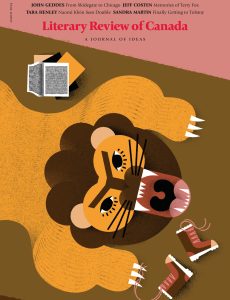
Literary Review of Canada Magazine March 2024
English | 44 pages | pdf | 16.69 MB
BACK IN NOVEMBER, A REAL ESTATE developer in New York purchased a single twenty-four-cent stamp for $2 million (U.S.). Issued by the United States Post Office in May 1918, the design places a red frame around a blue Curtiss JN-4, a First World War training aircraft that the postal service had just started using to deliver mail. To be printed with two colours, sheets of the stamp had to go onto a flatbed press twice. On one of those sheets — each with 100 individual stamps—the biplane was accidentally turned upside down.
While it’s certainly the most coveted stamp in American philately, the Inverted Jenny was not the first printing mistake in the postalservice’s history. Several images were inverted in a pictorial series from 1869, for instance. Then in May 1901, ahead of the Pan-American Exposition in Buffalo, a few ships, trains, and electric cars entered circulation miraculously defying gravity. Australia, Belgium, India, Jamaica, Malta, and New Zealand have all issued similar mistakes over the years, as has Canada, which flipped the maple leaf and the bald eagle on 400 of the five-cent St. Lawrence Seaway stamps that were released in 1959.
Because they’re still quite rare, such curiosities will always be priced beyond my reach. But in 1994, I was able to get my twelve-year-old hands on a sheet of twenty cowboy stamps, the Legends of the West pane, that had been printed using the wrong likeness of the African American rodeo star Bill Pickett the previous year. (The designers had depicted Bill’s brother Ben by mistake.) Having run five million panes before realizing its gaffe and changing the illustration, the United States Postal Service eventually distributed 150,000 of the recalled sheets in something of a lottery system—to recoup production costs and to help deflate the value of the few erroneous Pickett stamps that had managed to get out and make it to auction.
After my mail-in entry had been selected, I paid face value—$5.80—for a faulty Legends of the West pane and again for a corrected version. My burgeoning stamp collection already had some fine examples, including most of the sixteen Columbian Exposition commemorative stamps from 1893, but I felt like I had hit pay dirt. Today, the error sheet in mint condition might fetch a few hundred bucks, though I can’t imagine selling mine anytime soon.
Whether on a stamp or in a book, mistakes can fascinate and delight. Printed in 1631, an edition of the King James Bible sold by Robert Barker and Martin Lucas commanded readers, “Though shalt commit adultery.” The original edition of Mark Twain’s The Adventures of Huckleberry Finn, from 1885, transposed the letters of several words, including the final one in this sentence: “I took the bag to where it used to stand, and ripped a hole in the bottom of it with the was.” And Henry Miller’s Tropic of Cancer was riddled with errors when it first appeared in the U.S. in 1961. “No book is published without typos,” the publisher Anna Porter wrote in her 2018 memoir, In Other Words. The same could be said about most periodicals, especially those with a substantial amount of copy. Of course, some infelicities are more noticeable—and more embarrassing to their creator—than others. And a prime example of the truly noticeable kind occurred in the January/February 2024 number of this magazine.
As many readers have pointed out, “In the Spotlight,” Christopher Moore’s three-book review of the most recent Cundill History Prize finalists, was interrupted after 925 words when a previously published piece, George Anderson’s “Chin Up, Canada,” from our December 2023 issue, made a surprise appearance on page 14. As a result, a thousand of Moore’s words—along with a poem by T.R. Minamoto—were nowhere to be found. (The online and tablet versions of the magazine were unaffected.)
If I was delighted when I received one of those Legends of the West error sheets, I was chagrined when I realized our entire print run had bungled
a review, had omitted a poem, and would cause such confusion for so many readers—and that Ihad not seen the misprint before it went out into the world. This was far worse than any typo, far worse than the time, when I was the managing editor of a different magazine, when we placed the wrong bar code on newsstand copies.
A magazine’s pages are not printed in sequential order; they are engraved on metal plates in such a way as to appear in sequence when sheets of paper are folded and bound. It was during this imposition process that, somehow, the ghost of an earlier article announced itself. I doubt we’ll ever laugh about the howler, though we’llsurely use it as a cautionary tale. For now, we are including a proper version of those flawed pages as a supplement to this month’s, along with our sincere apologies.
Kyle Wyatt, Editor-in-Chief
Download from: